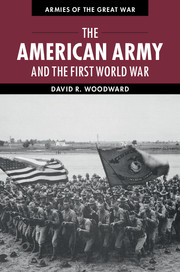Book contents
- Frontmatter
- Dedication
- Contents
- List of figures
- List of maps
- List of tables
- Preface
- List of abbreviations
- Introduction
- 1 Birth of a modern army
- 2 World war and American preparedness
- 3 Coercive power and Wilsonian diplomacy
- 4 “You’re in the army now”
- 5 US army doctrine and industrialized trench warfare
- 6 Over where?
- 7 American Expeditionary Force organization, overseas training, and deployment
- 8 Will the Americans arrive in time?
- 9 Failed expectations: “the military establishment of the United States has fallen down”
- 10 Atlantic ferry
- 11 Neck of the bottle
- 12 Uncertain times
- 13 Cantigny
- 14 Into the breach
- 15 American soldiers in north Russia and Siberia
- 16 The beginning of the end
- 17 Establishment of the American First Army and Saint-Mihiel
- 18 Meuse-Argonne, September 26–October 31
- 19 Breakout, November 1–11
- 20 Epilogue
- Notes
- Bibliography
- Index
17 - Establishment of the American First Army and Saint-Mihiel
Published online by Cambridge University Press: 05 July 2014
- Frontmatter
- Dedication
- Contents
- List of figures
- List of maps
- List of tables
- Preface
- List of abbreviations
- Introduction
- 1 Birth of a modern army
- 2 World war and American preparedness
- 3 Coercive power and Wilsonian diplomacy
- 4 “You’re in the army now”
- 5 US army doctrine and industrialized trench warfare
- 6 Over where?
- 7 American Expeditionary Force organization, overseas training, and deployment
- 8 Will the Americans arrive in time?
- 9 Failed expectations: “the military establishment of the United States has fallen down”
- 10 Atlantic ferry
- 11 Neck of the bottle
- 12 Uncertain times
- 13 Cantigny
- 14 Into the breach
- 15 American soldiers in north Russia and Siberia
- 16 The beginning of the end
- 17 Establishment of the American First Army and Saint-Mihiel
- 18 Meuse-Argonne, September 26–October 31
- 19 Breakout, November 1–11
- 20 Epilogue
- Notes
- Bibliography
- Index
Summary
On July 10, 1918 General Foch issued a statement from his headquarters at Bombon that could have been written by Pershing. “The day when there are one million Americans in France, America cuts a figure in the war,” he proclaimed. “America has a right to an American army; the American army must be. The Allied cause moreover will be better served by having an American army under the orders of its one leader, than by an American army scattered all about.”
Pershing and his staff enthusiastically received Foch’s statement but they wanted more than an independent army. Operational objectives were equally important, and they sought Foch’s approval of an advance toward Metz which had been percolating within Pershing’s staff since September 1917. Foch, however, favored Allied attacks from the Argonne Forest to Arras rather than in Lorraine. Fox Conner, chief of operations at GHQ, spoke for Pershing’s staff on July 14 when he wrote the following: “A campaign limited to the front planned by General Foch carries with it no reasonable prospect of final victory during 1919. This final victory can only be had by reaching the vitals of Germany and by destroying her armed forces. Since her vitals are in Lorraine the simplest method is to take the most direct road to that region.”
- Type
- Chapter
- Information
- The American Army and the First World War , pp. 298 - 322Publisher: Cambridge University PressPrint publication year: 2014

